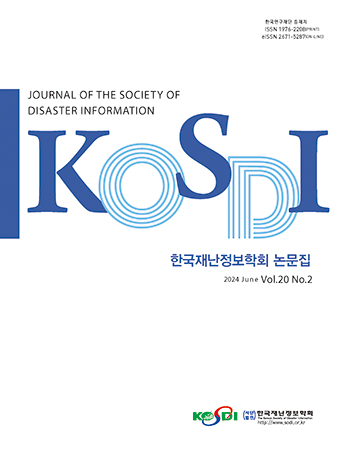Original Article
Abstract
References
Information
Purpose: This study is to develop a method for measuring dynamic speeding risks using vehicle trajectory big data and to demonstrate the feasibility of the devised speeding index. Method: The speed behaviors of vehicles were analysed in microscopic space and time using individual vehicle trajectories, and then the boundary condition of speeding (i.e., boundary speed) was determined from the standpoint of crash risk. A novel index for measuring the risk exposure of speeding was developed in microscopic space and time with the boundary speed. Result: A validation study was conducted with vehicle-GPS trajectory big data and ground-truth vehicle crash data. As a result of the analysis, it turned out that the index of speeding-risk exposure has a strong explanatory power (R2=0.7) for motorway traffic accidents. This directly indicates that speeding behaviors should be analysed at a microscopic spatiotemporal dimension. Conclusion: The spatial and temporal evolution of vehicle velocity is very variable. It is, hence, expected that the method presented in this study could be efficaciously employed to analyse the causal factors of traffic accidents and the crash risk exposure in microscopic space using mobility trajectory data.
연구목적: 본 연구는 대용량 차량궤적 자료를 이용하여 동적 과속 위험성을 측정하기 위한 방법론을 개발하고, 개발된 과속 지표의 적용성을 증명하는데 있다. 연구방법: 개별 차량 궤적을 이용하여 차량의 속도 변화를 미시적 시공간으로 분석하고, 사고 위험성 관점에서 과속의 경계(즉, 경계속도)를 결정하였다. 결정된 경계속도를 이용하여 미시적 시공간 기반 과속 노출도 지표를 개발하였다. 연구결과: 검증 연구는 대용량 차량 GPS 궤적 자료와 실제 교통사고 자료를 이용하여 수행되었다. 분석결과, 개발된 과속 노출도 지표는 고속도로 교통사고에 대해 우수한 설명력 (R2=0.7)을 보였다. 이는 미시적 시공간 차원에서 과속이 분석되어야 함을 직접적으로 의미한다. 결론: 차량 속도 상태의 시공간적 변화는 매우 가변적이다. 따라서 본 연구에서 제시된 방법론은 차량 궤적 자료를 이용한 미시적인 공간기반 교통사고 요인 및 사고 위험 노출도 분석에 효과적으로 활용될 수 있을 것으로 판단된다.
- daily traffic for unmeasured road segments." Transportation, Vol. 46, pp. 1011-1032.
- Chang, H., Yoon, B. (2018). "High-speed data-driven methodology for real-time traffic flow predictions: Practical applications of ITS." Journal of Advanced Transportation, Vol. 2018, 5728042. 10.1155/2018/5728042
- Elvik, R. (2009). The Power Model of the relationship between speed and road safety. Update and new analyses. Report 1034/2009, Institute of Transport Economics, Oslo, Norway.
- Garber, N.J., Ehrhart, A.A. (2000). "Effect of speed, flow, and geometric characteristics on crash frequency for two-lane highways." Transportation Research Record: Journal of the Transportation Research Board, Vol. 1717, No. 1, pp. 76-83. 10.3141/1717-10
- Garber, N.J., Gadiraju, R. (1989). "Factors affecting speed variance and its influence on accidents." Transportation Research Record, Vol. 1213, pp. 64-71.
- Kong, X., Das, S., Jha, K., Zhang, Y. (2020). "Understanding speeding behavior from naturalistic driving data: Applying classification based association rule mining." Accident Analysis & Prevention, Vol. 144, 105620. 10.1016/j.aap.2020.105620 32570086
- Pei, X., Wong, S.C., Sze, N.N. (2012). "The roles of exposure and speed in road safety analysis." Accident Analysis & Prevention, Vol. 48, pp. 464-471. 10.1016/j.aap.2012.03.005 22664713
- Quddus, M. (2013). "Exploring the relationship between average speed, speed variation, and accident rates using spatial statistical models and GIS." Journal of Transportation Safety & Security, Vol. 5, No. 1, pp. 27-45. 10.1080/19439962.2012.705232
- Richards, D., Cuerden, R. (2009). "The relationship between speed and car driver injury severity." Road Safety Web Publication 9, Department for Transport, London, U.K.
- Shim, J., Park, S.H., Chung, S., Jang, K. (2015). "Enforcement avoidance behavior near automated speed enforcement areas in Korean expressways." Accident Analysis and Prevention, Vol. 80. pp. 57-66. 10.1016/j.aap.2015.03.037 25909388
- Taylor, M.C., Baruya, A., Kennedy, J.V. (2002). The relationship between speed and accidents on rural single-carriageway roads. TRL Report 511, Transport Research Laboratory, Crowthorne, Berkshire.
- Yu, R., Abdel-Aty, M. (2013). "Utilizing support vector machine in real-time crash risk evaluation." Accident Analysis & Prevention, Vol. 51, pp. 252-259. 10.1016/j.aap.2012.11.027 23287112
- Yu, R., Quddus, M., Wang, X., Yang, K. (2018). "Impact of data aggregation approaches on the relationships between operating speed and traffic safety." Accident Analysis & Prevention, Vol. 120, pp. 304-310. 10.1016/j.aap.2018.06.007 30195137
- Wang, X., Zhou, Q., Quddus, M., Fan, T., Fang, S. (2018). "Speed, speed variation and crash relationships for urban arterials." Accident Analysis & Prevention, Vol. 113, pp. 236-243. 10.1016/j.aap.2018.01.032 29433070
- Publisher :The Korean Society of Disaster Information
- Publisher(Ko) :한국재난정보학회
- Journal Title :Journal of the Society of Disaster Information
- Journal Title(Ko) :한국재난정보학회논문집
- Volume : 17
- No :3
- Pages :655-666
- DOI :https://doi.org/10.15683/kosdi.2021.9.30.655




 Journal of the Society of Disaster Information
Journal of the Society of Disaster Information







